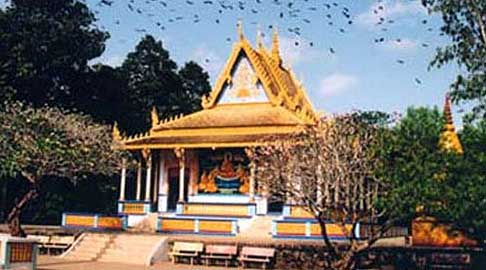Doi pagoda of the Khmer
 |
| Doi pagoda |
Doi pagoda was built in the 16th century in Soc Trang province.
The pagoda’s name in the Khmer language is Seray Tocho Mahatup. Its popular name is Doi because it’s home to thousands of bats.
Doi pagoda is a museum of Khmer culture and art, reflected in the pagoda gate, main hall, and monks’ accommodations.
The pagoda features Khmer architecture with engraved patterns of lotus leaves. The pagoda is in the centers of a 3-ha orchard.
Hoang Van Viet, a tour guide from Ho Chi Minh city shared, “Looking out the main hall, the pagoda’s facilities appear harmonious with their surroundings, which creates a peaceful feeling. It’s tranquil and relaxed here.”
From the entrance, visitors can be overwhelmed by the bright, shiny yellow color that almost completely covers the entire pagoda. The four corners of the pagoda roof are engraved with Naga cobras and a tower rises high in the middle.
Support pillars along the corridor surrounding the main hall are statues of Kemnar maidens with hands held chest-high in a welcoming gesture to all visitors.
The walls are decorated with 28 paintings about Buddha’s life from his birth until he entered Nirvana. Inside the hall is a statue of Buddha sitting high on a lotus throne.
Viet said, “The hall is the most important place in a pagoda. Khmer Theravada worships only Buddha in the main hall. Kinh pagodas worship Buddha and other Bodhisattvas.”
Around the main hall are stupas containing relics of monks and houses for monks. Doi pagoda embodies Khmer architectural values and traditions. It’s a place for Khmer people to attend religious activities and festivals, enjoy cultural performances, and study.
Tran Van Nam lives near Doi pagoda. He noted, “I offer incense at the pagoda every morning. Khmer people gather here to make Chung cakes for Tet and worship their ancestors. People come here to pray on the first and 15th day of the month. In the Donta festival, people worship at home for three days and then attend a ceremony at the pagoda to pray to their ancestors.”
Doi pagoda’s garden filled with ancient trees and younger fruit trees is home to thousands of bats. Mysteriously, they live in the fruit trees but never eat fruit in the pagoda. When it begins to get dark, they leave the pagoda to find food elsewhere.
What the stars mean:
★ Poor ★ ★ Promising ★★★ Good ★★★★ Very good ★★★★★ Exceptional
Latest News
More News
- The destinations powering Vietnam’s festive season travel demand (December 04, 2025 | 18:33)
- Vietnam named among the world’s most exciting winter destinations (December 04, 2025 | 15:10)
- Phu Tho emerges as northern Vietnam’s new tourism hub (December 01, 2025 | 17:00)
- Vietjet completes Airbus A320/A321 updates ahead of deadline (December 01, 2025 | 09:49)
- Vietjet resumes Con Dao flights from early December (November 28, 2025 | 15:24)
- Free tickets, Lunar New Year promotions on offer at Vietjet Mega Livestream (November 26, 2025 | 15:32)
- Scandinavian Airlines and Vietnam Airlines broaden agreement with new routes (November 25, 2025 | 17:04)
- Halong Cruise Port welcomes over 3,100 international visitors (November 12, 2025 | 18:06)
- Vietnam.travel climbs to second place in Southeast Asia website rankings (November 12, 2025 | 18:01)
- Cat Ba named among Southeast Asia’s top island adventures (November 11, 2025 | 18:09)

















 Mobile Version
Mobile Version